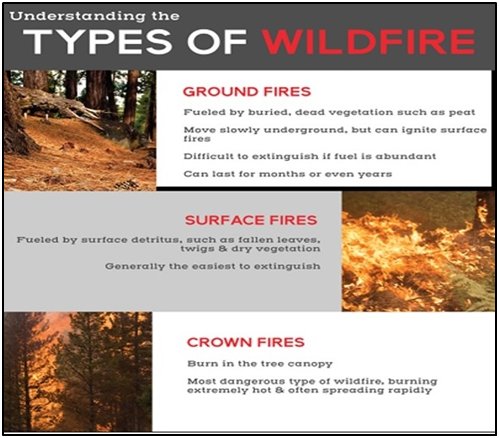Forest fires the Nilgiris
19-03-2024
10:59 AM

What’s in today’s article?
- Why in news?
- What are Forest Fires/Wildfires?
- How common are forest fires in India?
- What is the reason for the fires this year?

Why in news?
For the past one week, forest fires have been raging in the Coonoor forest range in the Nilgiris in Tamil Nadu.
Recently, the Indian Air Force joined the ongoing firefighting efforts of the state forest department. IAF has deployed an Mi-17 V5 helicopter to conduct multiple Bambi Bucket operations that dumped some 16,000 litres of water on the fires.
What are Forest Fires/Wildfires?
- Meaning: It is an unplanned, uncontrolled and unpredictable fire in an area of combustible vegetation.
- Causes: Natural (lightning, high atmospheric temperatures and low humidity (dryness) and man-made (agricultural practices like Jhum, a source of fire (cigarette, bidi, etc)].
- Types of forest fire:
How common are forest fires in India?
- Period
- November to June is considered to be forest fire season in India, with hundreds of thousands of small and large fires burning every year.
- April-May are usually the worst fire months across the country.
- Affected areas
- The biennial India State of Forest Report (ISFR) recorded in its 2019 report that more than 36% of India’s forest cover was prone to frequent fires.
- ISFR is published by the Forest Survey of India (FSI) under the Ministry of Environment, Forest and Climate Change.
- About 4% of the forest cover was extremely prone to fire, and another 6% was very highly fire prone.
- The biennial India State of Forest Report (ISFR) recorded in its 2019 report that more than 36% of India’s forest cover was prone to frequent fires.
- Most forest fires Regions
- According to the FSI, severe fires break out in dry deciduous forests, while evergreen, semi-evergreen, and montane temperate forests are comparatively less prone to fires.
- The forests of Northeast India, Odisha, Maharashtra, Jharkhand, Chhattisgarh, and Uttarakhand are the most vulnerable to fires.
- In March 2023, large bushfires raged in Goa, triggering an investigation into whether they were man-made.
- In 2021, a series of forest fires broke out in Uttarakhand, Himachal Pradesh, Nagaland-Manipur border, Odisha, Madhya Pradesh, and Gujarat, including in wildlife sanctuaries.
- Forest fires incidents of 2024
- Over the past one week, the highest number of forest fires have been reported from Mizoram (3,738), Manipur (1,702), Assam (1,652), Meghalaya (1,252), and Maharashtra (1,215).
- Forest fires have been on an uptick since early March along the:
- Konkan belt in Maharashtra,
- south-coastal Gujarat along Gir Somnath and Porbandar,
- southern Rajasthan and adjoining south-western districts of Madhya Pradesh,
- coastal and interior Odisha, and adjoining Jharkhand.
- In South India, most forest covered areas of Andhra Pradesh, Karnataka and Tamil Nadu have seen fire incidents over the past week.
- Forest fires in South India
- Some forest areas in Andhra Pradesh and Telangana are fire-prone.
- However, according to the FSI, forests in southern India are comparatively less vulnerable to fires, as the vegetation type is mainly evergreen or semi-evergreen.
- That said, Tamil Nadu has been reporting wildfires in its forests in recent years.
What is the reason for the fires this year?
- Climatic conditions
- This year, high aridity, above-normal day temperatures, clear sky conditions, and calm winds during the early phase of the summer season are some of the contributory factors for the spike in forest fire incidents in southern India.
- Temperature in Southern India
- February 2024 was exceptionally hot over Southern India in particular.
- It was South India’s hottest since 1901, and January was the fifth warmest in more than a century.
- High heat load
- Over the past two months, the recorded maximum, minimum, and mean temperatures have remained above-normal over the southern states.
- This has helped build the heat load over the region well before the onset of the summer season.
- As a result, there has been an early availability of dry biomass in these forests since the winter season itself.
- Prevalence of Excess Heat Factor (EHF)
- The IMD has warned of the prevalence of EHF to be significantly higher than normal over western Andhra Pradesh and neighbouring Karnataka.
- EHF is a value that predicts the chances of a heatwave over a region.
- Maximum temperatures touched 40 degrees Celsius here last week, unusual for mid-March.
- The IMD has warned of the prevalence of EHF to be significantly higher than normal over western Andhra Pradesh and neighbouring Karnataka.
- Mild aridity in southern India
- In the absence of rain and prevailing high temperatures, the IMD has classified almost all districts of southern India under mild aridity.
Q1) What is the Excess Heat Factor (EHF)?
The Excess Heat Factor (EHF) is a metric for measuring the intensity of heat waves and categorizing their severity.
Q2) What are Nilgiris?
The Nilgiris are a mountain range in India that spans the borders of Tamil Nadu, Karnataka, and Kerala, and is part of the Western Ghats. The Nilgiris are located at the junction of three states and connect the Western Ghats with the Eastern Ghats. The highest point on the Nilgiri mountains is Doddabetta, which is about 2,637 meters high. The Nilgiris district includes several hill stations, including Ooty, Coonoor, and Kotagiri.


